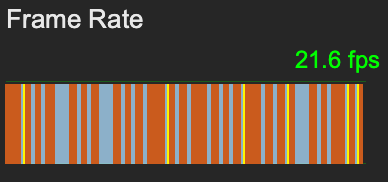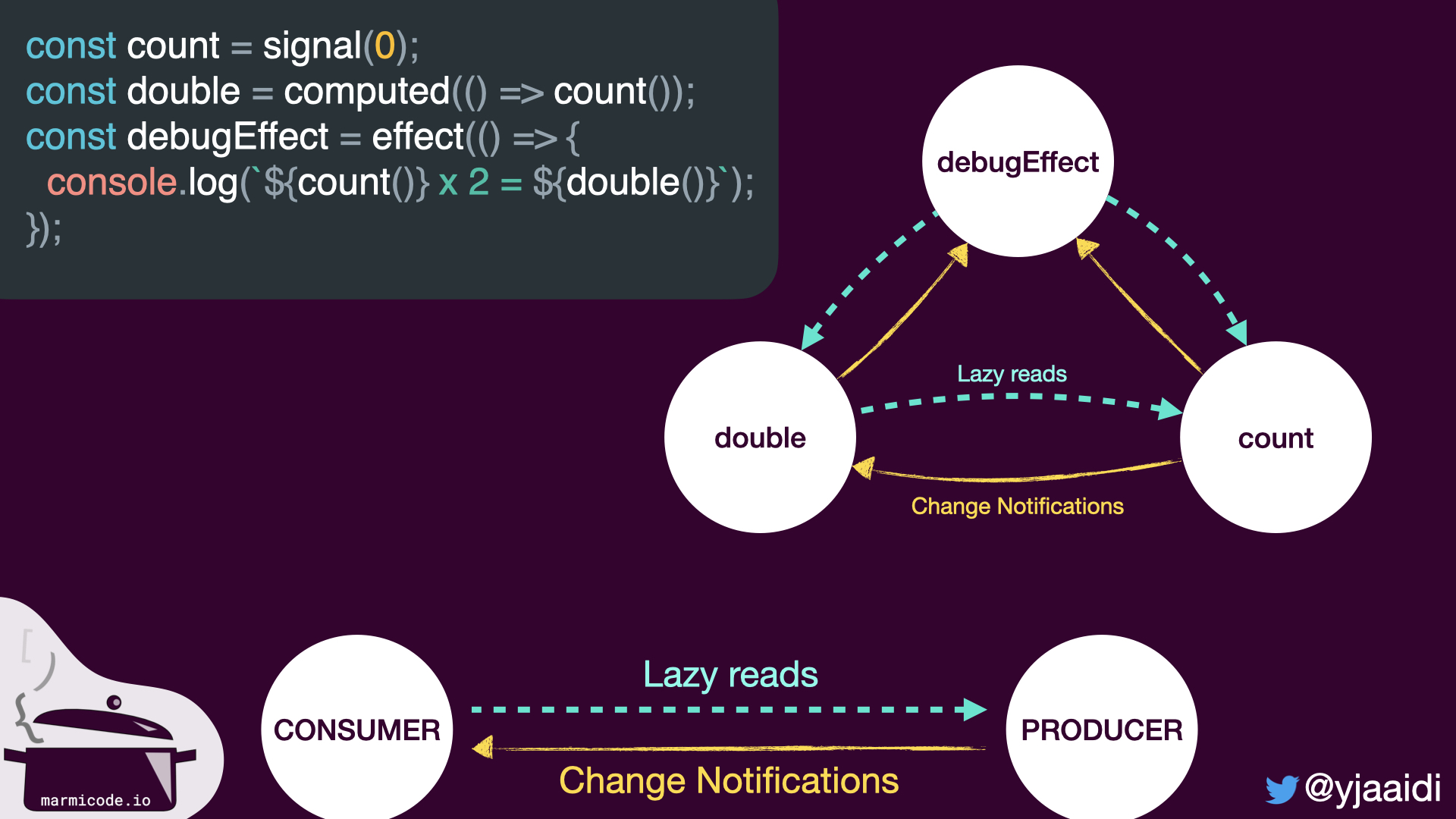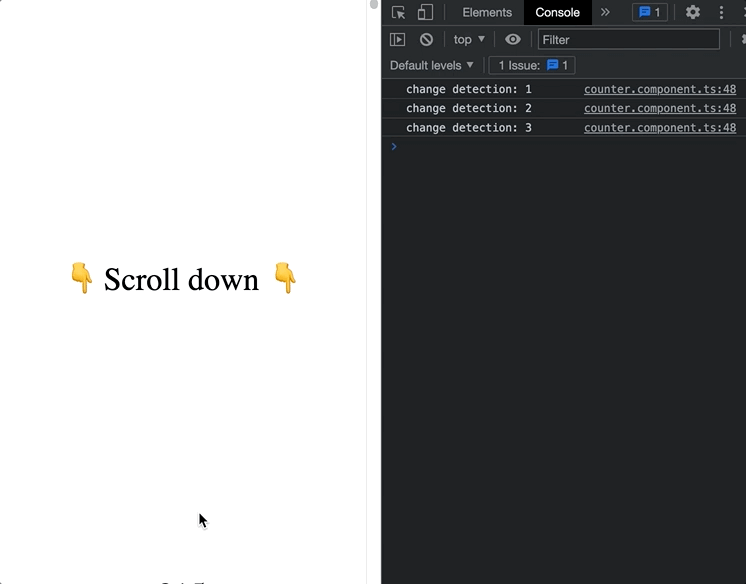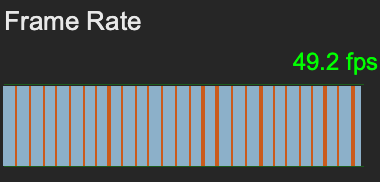TL;DR: Angular Signals might make it easier to track all the expressions in a view (Component or EmbeddedView) and schedule custom render strategies in a very surgical way. Thus, enabling some exciting optimizations.
While libraries and frameworks are getting better and better at tracking changes in a fine-grained way and propagating them to the DOM, we might notice that sometimes, the performance bottleneck resides in DOM updates.
Let's explore how Angular Signals could allow us to overcome these performance bottlenecks with custom rendering strategies.
📜 From Tick to Sig
It has been a while now since the Angular team has been exploring (way more than we can think) alternative reactivity models and looking for something that lies between the extremes of naive Zone.js (i.e. Zone.js without OnPush) and Zoneless Angular combined with special pipes & directives like those provided by RxAngular.
... then Pawel Kozlowski joined the Angular team as a full-time member and together with Alex Rickabaugh they merged into Pawælex.
In the meantime, while Ryan Carniato keeps insisting that he did not invent Signals, he undoubtedly made them popular in the JavaScript ecosystem (Cf. The Evolution of Signals in JavaScript) and eventually ended up influencing Angular.
That is how Pawælex & friends: Andrew, Dylan & Jeremy made the Angular Signals RFC happen.
😬 DOM updates are not that cheap
The fantastic thing about Signals is how frameworks and libraries like Angular, SolidJS, Preact or Qwik "magically" track changes and rerender whatever has to rerender without much boilerplate compared to more manual alternatives.
But wait! If they rerender whatever has to rerender, what happens if the performance bottleneck is the DOM update itself?
Let's try updating 10.000 elements every 100ms...
@Component({
...
template: `
<div *ngFor="let _ of lines">{{ count() }}</div>
`,
})
export class CounterComponent implements OnInit {
count = signal(0);
lines = Array(10_000);
ngOnInit() {
setInterval(() => this.count.update(value => value + 1), 100);
}
}
Oups! We're spending more than 90% of our time rendering...
...and we can notice the frame rate dropping to somewhere around 20fps.
🦧 Let's calm down a bit
The first solution which we might think of is simply updating the Signals only when we want to rerender, but that would require some boilerplate (i.e. creating intermediate Signals, which are not computed Signals!), and this is how it would look like if we want to throttle a Signal:
@Component({
...
template: `{{ throttledCount() }}`
})
class MyCmp {
count = signal(0);
throttledCount = throttleSignal(this.count, {duration: 1000});
...
}
Cf. throttleSignal().
but this has a couple of drawbacks:
- 🐞 using a single unthrottled Signal in the same view would defeat our efforts,
- ⏱️ if intermediate Signals scheduled updates are not coalesced, we might introduce some random inconsistencies and break the whole glitch-free implementation of Signals.
📺 Updating the viewport only
What if the browser was sensitive? It would turn to us and say: "I'm tired of working so much and nobody cares about my efforts! From now on, I won't work if you don't look at me!"
We might probably agree!
In fact, why would we keep updating below the fold elements? Or more generally, why would we keep updating elements outside the viewport?
If we tried to implement this using an intermediate Signal, then the function would need a reference to the DOM element in order to know if it's in the viewport:
lazyCount = applyViewportStrategy(this.count, {element});
this would require more boilerplate and as the same Signal might be used in different places, then we would need an intermediate Signal for each usage.
While this could be solved using a structural directive, we would clutter the template instead:
template: `
<span *lazyViewportSignal="count(); let countValue">{{ countValue }}</span>
<span> x 2 = </span>
<span *lazyViewportSignal="double(); let doubleValue">{{ doubleValue }}</span>
`
... which is far from ideal.
🤔 What about Eventual Consistency for DOM updates?
Another alternative is acting at the change detection level. If we can customize the rendering strategy, then we can easily postpone the rendering of the content below the fold.
More precisely, we could stop updating the content outside the viewport until it's in the viewport.
While introducing such inconsistency between the state and the view might sound frightening. If applied wisely, this is nothing more than Eventual Consistency, meaning that we will eventually end up in a consistent state.
After all, we could state the following theorem (obviously inspired by the CAP Theorem)
The process of synchronizing the state and the view can't guarantee both consistency and availability.
Inspired by the work of my RxAngular friends, I thought that by combining something like custom render strategies with the Signals tracking system, we could get the best of both worlds and achieve our goal in the most unobtrusive way.
This could look something like this:
@Component({
...
template: `
<div *viewportStrategy>
<span>{{ count() }}</span>
<span> x 2 = </span>
<span>{{ double() }} </span>
</div>
`,
})
export class CounterComponent implements OnInit {
count = Signal(0);
double = computed(() => count());
}
👨🏻🍳 Sneaking between Signals & Change Detection
Obviously, my first move was to ask the Angular team (more precisely, my dear friend Alex who is now part of Pawælex as mentioned before) if there were any plans to provide an API to override how Signals trigger Change Detection.
Alex said: no.
I heard: not yet.
Then I said: thanks.
And we simultaneously said: bye.
That's when I put on my coding apron and started trying some naive stuff.
My first try was nothing more than something like this:
/**
* This doesn't work as expected!
*/
const viewRef = vcr.createEmbeddedView(templateRef);
viewRef.detach();
effect(() => {
console.log('Yeay! we are in!'); // if called more than once
viewRef.detectChanges();
});
... but it didn't work.
The naive idea behind this was that if
effect()can track Signal calls and ifdetectChanges()has to synchronously call the Signals in the view, then the effect should run again each time a Signal changes.
That's when I realized that we are lucky that this doesn't work because otherwise, this would mean that we would trigger change detection on our view whenever a Signal changes in any child or deeply nested child.
Something at the view level stopped the propagation of the Signals and acted as a boundary mechanism. I had to find what it was, and the best way was to jump into the source code.
(Yeah! I know... I like to try random stuff first 😬)
🔬 The Reactive Graph
In order for the Signals to track changes, Angular has to build a reactive graph. Each node in this graph extends the ReactiveNode abstract class.
There are currently four types of reactive nodes:
-
Writable Signals:
signal() -
Computed Signals:
computed() -
Watchers:
effect() - the Reactive Logical View Consumer: the special one we need 😉 (the introduction of Signal-based components will probably add more node types like component inputs)
Each ReactiveNode knows all of its consumers and producers (which are all ReactiveNodes). This is necessary in order to achieve the push/pull glitch-free implementation of Angular Signals.
This reactive graph is built using the setActiveConsumer() function which sets the currently active consumer in a global variable which is read by the producer when called in the same call stack.
Finally, whenever a reactive node might have changed, it notifies its consumers by calling their onConsumerDependencyMayHaveChanged() method.
🎯 The Reactive Logical View Consumer
While spelunking, and ruining my apron, I stumbled upon a surprising reactive node type that lives in IVy' renderer source code, the ReactiveLViewConsumer.
While writable Signals are the leaf nodes of the reactive graph, the Reactive Logical View Consumers are the root nodes.
Just like any other reactive node, this one implements the onConsumerDependencyMayHaveChanged() method, but not like any other reactive node, this one is bound to a view so it can control the change detection... and it does! by marking the view as dirty when notified by a producer:
onConsumerDependencyMayHaveChanged() {
...
markViewDirty(this._lView);
}
🐘 Sneaking (like an elephant) between Signals & Change Detection
Sadly, there doesn't seem to be any elegant way of overriding the current behavior of marking the view to check when Signals trigger a change notification...
...but, luckily, I have my coding apron on, so I am not afraid of getting dirty.
1. Create the embedded view
First, let's create a typical structural directive so we can create & control the embedded view.
@Directive({
standalone: true,
selector: '[viewportStrategy]',
})
class ViewportStrategyDirective {
private _templateRef = inject(TemplateRef);
private _vcr = inject(ViewContainerRef);
ngOnInit() {
const viewRef = this._vcr.createEmbeddedView(this._templateRef);
}
}
2. Trigger change detection once
For some reason, the ReactiveLViewConsumer is instantiated after the first change detection. My apron was already too dirty to dive any deeper, but my guess is that it is lazily initialized when Signals are used for performance's sake.
The workaround is to trigger change detection once before detaching the change detector:
viewRef.detectChanges();
viewRef.detach();
Aha! While writing this, I stumbled upon this comment here... so I was right! Finally once! Yeah!
3. Grab the ReactiveLViewConsumer
🙈
const reactiveViewConsumer = viewRef['_lView'][REACTIVE_TEMPLATE_CONSUMER /* 23 */];
4. Override the Signal notification handler like a monkey
Now that we have the ReactiveLViewConsumer instance, we can let the hacker in us override the onConsumerDependencyMayHaveChanged() method and trigger/skip/schedule change detection with the strategy of our choice, like a naive throttle:
let timeout;
reactiveViewConsumer.onConsumerDependencyMayHaveChanged = () => {
if (timeout != null) {
return;
}
timeout = setTimeout(() => {
viewRef.detectChanges();
timeout = null;
}, 1000);
};
... or we can use RxJS which is still one of the most convenient ways of handling timing-related strategies (and it is already bundled anyway in most apps 😉)
Cf. ThrottleStrategyDirective & ViewportStrategyDirective
🚀 and it works!
Let's try!
This seems to be at least 5 times faster... (even though, tracking the element's appearance in the viewport is a relatively expensive task)
and the frame rate is pretty decent:
... but note that:
This might break in any future version (major or minor) of Angular. Maybe, you shouldn't do this at work.
Also, this only tracks the view handled by the directive. It won't detach and track child views or components.
🔮 What's next?
🚦 RxAngular + Signals
The strategies implemented in our demo are willingly naive and need better scheduling and coalescing to reduce the amount of reflows & repaints.
Instead of venturing into that, this could be combined with RxAngular Render Strategies... wink, wink, wink! 😉 to my RxAngular friends.
🅰️ We might need more low-level Angular APIs
To achieve our goal, we had to hack our way into Angular internals which might change without notice in future versions.
If Angular could provide some additional APIs like:
interface ViewRef {
/* This doesn't exist. */
setCustomSignalChangeHandler(callback: () => void);
}
... or something less verbose 😅, we could combine this with ViewRef.detach() and easily sneak in between Signals and change detection.
Signal-Based Components
As of today, Signal-based components are not implemented yet so there is no way to know if this would work, as implementation details will probably change.
⚛ Custom Render Strategies in some other Libraries & Frameworks
What about other libraries and frameworks?
I couldn't refrain from asking, so I did and received interesting feedback from SolidJS's Ryan Carniato & Preact's Jason Miller:
SolidJS
Preact
React
In React, no matter if we are using Signals or not, we could implement a Higher Order Component that decides whether to really render or return a memoized value depending on its strategy.
const CounterWithViewportStrategy = withViewportStrategy(() => <div>{count}</div>);
export function App() {
...
return <>
{items.map(() => <CounterWithViewportStrategy count={count}/>}
</>
}
Cf. React Custom Render Strategies Demo
This could probably be more efficient with Signals if achieved by wrapping React.createElement like Preact Signals integration does and implementing a custom strategy instead of the default behavior.
Or maybe, using a custom hook based on useSyncExternalStore().
Vue.js
Using JSX, we could wrap the render() just like withMemo() does:
defineComponent({
setup() {
const count = ref(0);
return viewportStrategy(({ rootEl }) => (
<div ref={rootEl}>{ count }</div>
));
},
})
Cf. throttle example on Stackblitz
... but I'm still wondering how this could work in SFC without having to add a compiler node transform to convert something like v-viewport-strategy into a wrapper. 🤔
Qwik
This one needs a bit more investigation 😅, and I am not sure if overriding the default render strategy is currently feasible.
However, my first guess would be that this can be "qwikly" added to the framework.
For example, there could be an API allowing us to toggle a component's "DETACHED" flag which would skip scheduling component render in notifyRender().
👨🏻🏫 Closing Observations
☢️ Please, don't do this at work!
The presented solution is based on internal APIs that might change at any moment, including the next Angular minor or patch versions.
So why write about it? My goal here is to show some new capabilities that could be enabled thanks to Signals while improving the Developer eXperience at the same time.
Wanna try custom render strategies before switching to Signals?
Check out RxAngular's template
Conclusion
While custom render strategies can instantly improve performance in some specific situations, the final note is that you should prefer keeping a low number of DOM elements and reducing the number of updates.
In other words, keep your apps simple (as much as you can), organized, and your data flow optimized by design using fine-grained reactivity (whether you are using RxJS-based solutions, or Signals).
🔗 Links & Upcoming Workshops
👨🏻🏫 Workshops











Top comments (3)
Great post!
Thanks Pedro 🙏
Excellent article! This outlines how Signals can outperform the previously available directions such as relying on OnPush and simply avoiding Angular events.
We're trying to push this Signals concept super hard at github.com/Recruitler/drag-drop/is...
we've forked the Angular drag-drop CDK to add nesting, pagination, signals and virtualizing the list elements with this approach.
Any input would be appreciated! Especially now that we have V17.